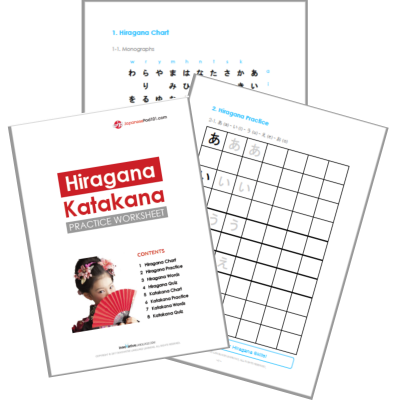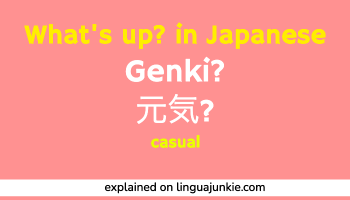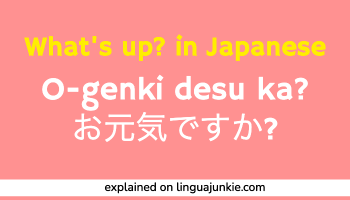How do you say whats up in Japanese?
It’s not hard. Very similar saying how are you in Japanese.
In fact, you literally can just use ONE word, “Genki,” to ask AND reply to what’s up in Japanese.
But hey, since you’re a smart person, you’ll learn 3+ common ways to say what’s up.
Formal, casual, and very slangy ways. Got it? So, keep on reading.
 | Want to learn how to write in Japanese? Download your FREE Japanese Alphabet eBook here. |
Genki?
- 元気?
- Literally: Healthy? Well?
- Intended meaning: What’s up?
- Casual
This first phrase is one the most common ways to say Whats up in Japanese amongst friends.
Listen to the Japanese pronunciation:
The pronunciation of the phrase is, “genki?”, and the translation is “are you well?” It is a casual way to ask someone how they are doing. When it is not used as a question, the word “genki” can also mean “well” or “healthy. ”
Fun fact! You also can say it back as a response to the original question. One person can ask “元気?”, and the other can say “元気” back. The literal translation of that interaction will be, “Healthy?” – “healthy”. An example of the phrase used in everyday conversation is:
- サム: ああ、久しぶり!元気?(aa, hisashiburi! Genki?)
- 一郎: おお、久しぶり!元気だよ!そっちは? (ohoh, hisashiburi! Genki dayo! Socchiwa?)
- Sam: oh hey, long time no see! Are you well?
- Ichirou: hey, long time no see! Yup, I am well! How about you?

O-genki desu ka?
- お元気ですか?
- Intended meaning: What’s up? How are you?
- More formal
With a slight modification, you can make this phrase formal. Instead of 元気, we say お元気. The pronunciation is, “o genki.” How? By adding お (pronounced “oh”) at the beginning of the word.
Listen to the Japanese pronunciation:
An important thing to remember is, you can say お元気ですか? (ogenki desuka?) as a question, but it cannot be used as a reply. Because you have the “ka” in there, which is how to ask questions in Japanese.
You can still use 元気 as a reply in this context.
Below is an example of a conversation where the phrase can be used:
- 一郎: ご無沙汰しております、お元気ですか? (Gobusatashite orimasu, ogenki desuka?)
- サム: こちらこそ、元気です。 (Kochirakoso, genki desu.)
- Ichirou : It has been a while, how are you?
- Sam: Likewise, I am well.
In this example, we can assume that Ichirou and Sam have a professional relationship. They are using formal Japanese to say whats up in Japanese and reply. One thing to note is they both use です (desu) at the end of their sentences. This is a suffix added commonly at the end of a sentence in formal Japanese, and it is a way to show respect.

Saikin Dou yo?
- 最近どうよ?
- Literal meaning: Recently how?
- What’s up? How have you been lately?
- Slang/Very Casual
This is a phrase that I personally use a lot. The phrase is 最近どうよ? The pronunciation is “saikin douyo?” This is a purely informal, slangish way to ask someone how they are doing, and in my opinion, the closest way you can say what’s up? in Japanese.
Listen to the Japanese pronunciation:
The phrase consists of two words, 最近(saikin) and どうよ (douyo).
Let’s define each part first. 最近 means “lately” or “recently”, while どうよ means “how are things?” or “How have you been?” どう(dou) is the root word here, and it can loosely be translated to “how”. For instance, どうしよう? (doushiyou) means “What am I going to do?” or “How am I going to do this?”
By adding aよ at the end, it turns to word into a slang way of asking, “How are things?”
So, put together, 最近どうよ? translates to, “How have you been, lately?” or more simply, “What’s up?” This is a slang phrase, so there is no way to make it formal.
Below are some examples of how the phrase can be used in everyday conversation:
- 一郎: で? 最近どうよ? (De? Saikin douyo?)
- サム: 最近? 暇してる。 (Saikin? Hima shiteru.)
- Ichirou: So? How have you been lately?
- Sam: Lately? I’ve been bored.
- 一郎: イヤー久しぶりだな! 最近どうよ? (Iyaa, hisashiburi dana! Saikin douyo?)
- サム: 最近本当忙しいよ。 (Saikin honto isogashiiyo)
- Ichirou: Wow, long time no see! What’s up?
- Sam: I’ve been so busy lately.
In both above examples, we can assume that Sam and Ichirou are good friends, and they are trying to catch up.
Unlike our previous phrase, 元気, we cannot use the phrase as a reply. Although it is acceptable to answer the question, “are you well?” with a reply such as, “I am tired”, it is equally acceptable to reply with “I am well.”
So, 元気 can be used as both the question and the answer, but 最近どうよ?is a phrase that is formed as a question. Therefore, we cannot use the same phrase as a reply.

Say Whats Up In Japanese – Review
Now you know how to say what’s up in Japanese.
Basically, “genki” is enough to say how are you or what’s up.
But you covered…
- Genki? (casual)
- O-genki desu ka? (formal)
- Saikin dou you? (very slang/informal)
If you want more similar phrases, there are my other guides…. like:
By the way, you should also hear REAL Japanese and its sounds.
So, if you’re interested, here’s a quick lesson greetings from JapanesePod101.
- Japanese Lesson – Where Are You From?
- Click here to get more fun Japanese lessons at JapanesePod101.
The Main Lingua Junkie